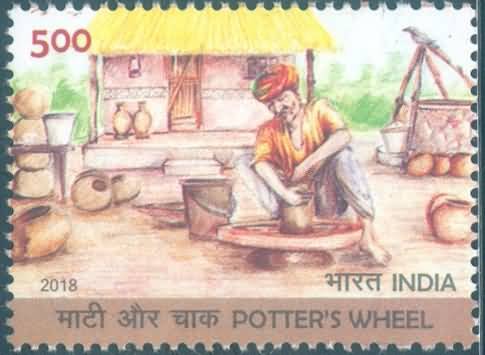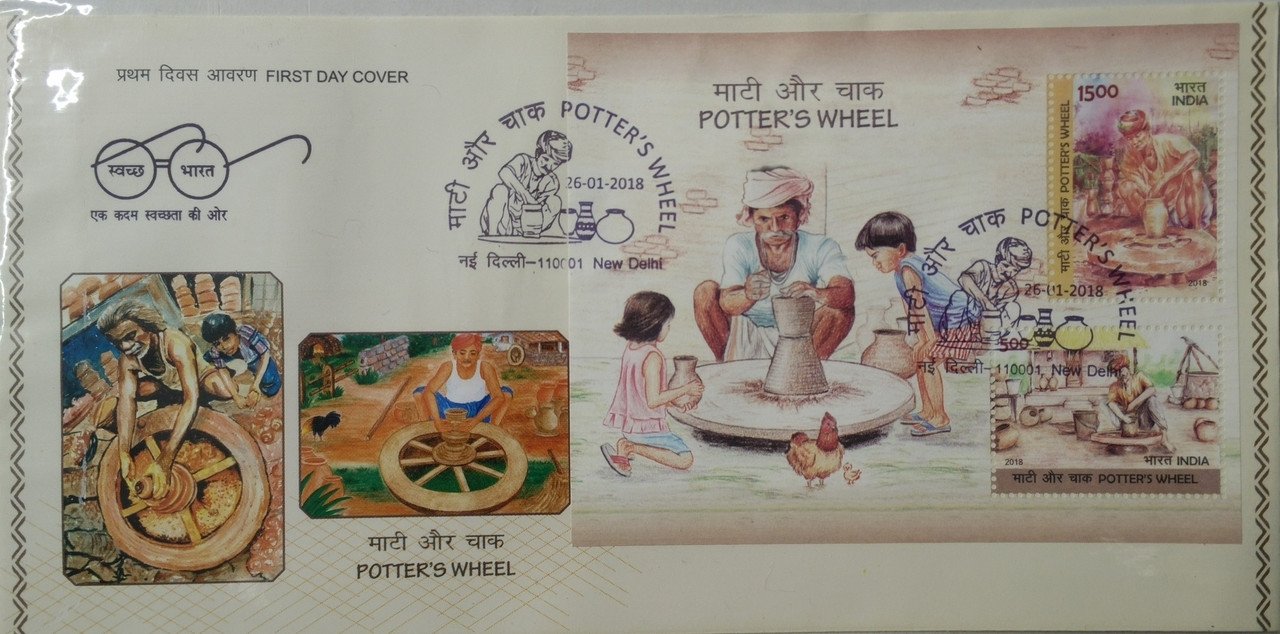Potter’s Wheel

Technical Data
| Date of Issue | January 26, 2018 |
|---|---|
| Denomination | Rs. 5 |
| Quantity | 500,000 |
| Perforation | 13¾ x 13¾ |
| Printer | Security Printing Press, Hyderabad |
| Printing Process | Wet Offset |
| Watermark | No Watermark |
| Colors | Multicolor |
| Credit (Designed By) | Ms. Nenu Gupta |
| Catalog Codes |
Michel IN 3343 Yvert et Tellier IN 3033 Stanley Gibbons IN 3470 |
| Themes | Crafts |
Stamp Design Competition on the Theme – “Potter’s Wheel”
Every year, on the occasions of Republic Day, Independence Day, and Children’s Day, the Department of Posts organizes an All India Level Stamp Design Competition. Initiated in 2015, this annual event encourages creativity and philatelic interest among citizens, especially the youth. The selected entries are awarded cash prizes, and the winning designs are used in the creation of postage stamps and other philatelic items.
This year, the competition was conducted on the inspiring theme of “Potter’s Wheel”, celebrating one of the oldest and most symbolic inventions in human history. With enthusiastic participation from all across the nation and the support of 23 Circle Offices, the Department received an overwhelming response.
The Ancient Art of Pottery
Pottery, the craft of shaping burnt clay into vessels, is among the earliest forms of human artistic expression. Archaeological excavations across the world have unearthed ancient pottery fragments, offering glimpses into early civilizations. The oldest evidence of pottery dates back to around 10,000 BC in Japan, highlighting its long-standing connection with human culture.
The emergence of pottery coincided with humanity’s shift from nomadic living to settled agriculture, when people required durable containers for storage. Initially, pottery was handmade using the coiling technique—rolling clay into long threads, coiling them up, and smoothing them into shape by hand. The base of early pots often bore impressions of mats or leaves, reflecting the surfaces they were crafted on.
Evolution of the Potter’s Wheel
The earliest potter’s wheel, known as the tournette or slow wheel, appeared around 4500 BC in the Near East. It allowed potters to rotate their vessels while coiling, thus improving symmetry and efficiency. However, production remained limited to a small range of shapes.
By the mid to late 3rd millennium BC, the fast wheel revolutionized pottery-making. Operated through momentum on the flywheel principle, it enabled the new technique of throwing—placing a lump of clay at the center of the wheel and shaping it while it spun. This innovation made pottery thinner, more refined, and varied in design. It also increased productivity, marking an early step toward industrialization in craftwork.
Recognition of Creative Talent
The Department of Posts received numerous artistic interpretations of the theme “Potter’s Wheel” from participants across India. After careful evaluation, eight entries were selected as prize-winning designs, submitted by:
- Mr. Abin Bhanu
- Mr. Gokul Raghavan
- Ms. Sonal Kewalramani
- Mr. Vysakh K. S.
- Mr. M. Vaibhav Shenoy
- Mr. Sanskar Verma
- Mr. Abhishek P.
- Mr. Sunit Namdev Wandre
Based on these creative entries, the Department has issued two postage stamps, a miniature sheet, a First Day Cover, and a brochure.
Additionally, five designs submitted by Ms. Bharati Ranjan Naik, Mr. Jayasooriyan S, Ms. Kumud Krishnakumar Kedia, Mr. Bandana Kumar, and Ms. Malavika Sunil have been selected for the release of five Maxim Cards.
Conclusion
Through the theme “Potter’s Wheel”, this year’s stamp design competition beautifully captures the spirit of creativity, tradition, and innovation. The initiative not only honours the timeless art of pottery but also celebrates India’s rich cultural heritage and artistic talent—shaping a bridge between ancient craft and modern expression through philately.
First Day Cover

